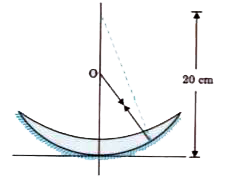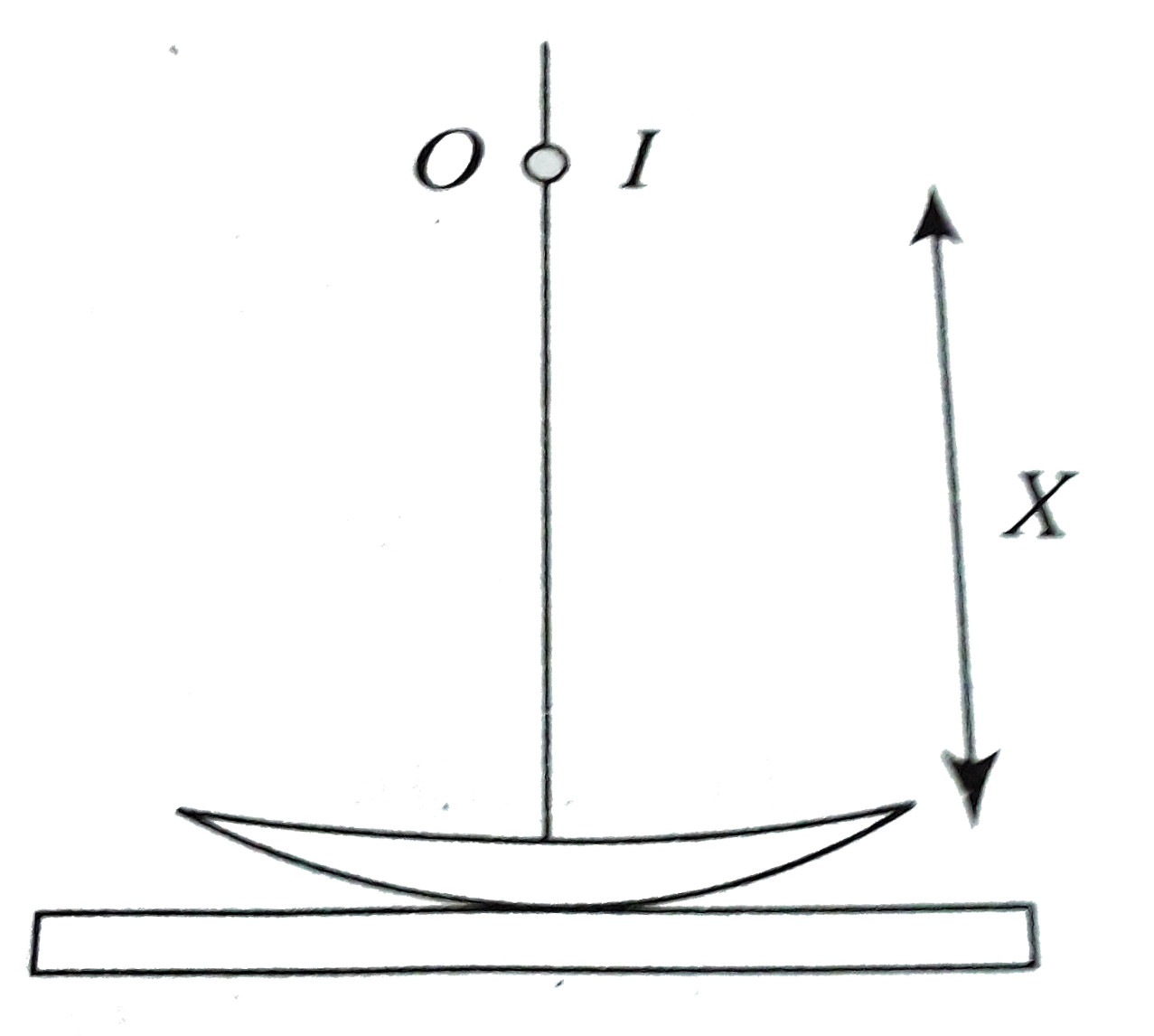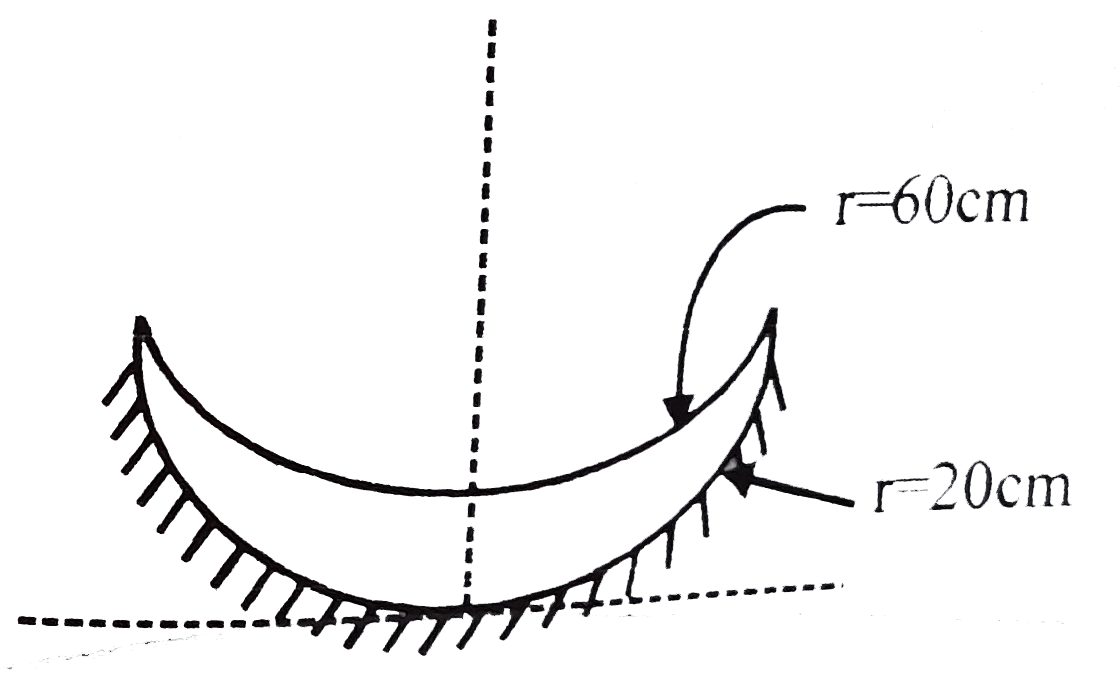The convex surface of a thin concave-convex lens of glass of refractive index 1.5 has a radius of curvature 20 cm. The concave surface has a radius of curvature 60 cm. The convex side is silvered and placed on a horizontal surface as shown in figure. (a) Where should a pin be placed on the axis so that its image is formed at the same place ? (b) If the concave part is filled with water (mu = 4/3), find the distance through which the pin should be moved so that the image of the pin again coincides with the pin.

(a) For the image to form at the same place as that of object , light rays must fall normally to the silvered surface so that they are turned right back and rays traverse their path back to object .

Radius of curvature of convex surface which is silvered is 20 cm . Hence , for the ray to fall normally on this surface , image distance in first refraction must be 20 cm . Applying refraction formula .
μ2v−μ1u=μ2−μ1R
Refraction is from air to glass hence , μ1=1 and μ2=1.5
⇒ 1.5(−20)−1μ=1.5−1(−60)
⇒−340−1u=−1120
⇒1u=1120−340
⇒ 1u=1−9120
⇒ u=−15 cm
Hence , object must be placed at a distance 15 cm from the lens .
(b) When water is filled on concave surface of lens then first refraction will be from air to water then second refraction from water to glass and this time image distance in second refraction should be equal to radius 20 cm .
Note that we can use the same refraction formula for refraction at plane surface also by putting R = infinity .
We have to use refraction formula twice .
Air to water
μ2v−μ1u=μ2−μ1R
43v.−1μ=43−1∞
43v.−1u=0 ...(i)
Image distance v. in previous refraction is object distance for next refraction from water to glass .
μ2v−μ1u=μ2−μ1R
⇒1.5−20−3v.=−53×600
⇒ −340−43v.=−1360 ....(ii)
Adding the equation (ii) with equation (i) we get the following :
⇒ −340−1u=−1360
⇒ 1u=1360−340
⇒ 1u=1−27360
⇒u=−36026 cm
⇒ u=−13.85 cm
Since new location of object is at 13.85 cm from the lens , hence , displacement from its earlier position is 15−13.85=1.15 cm .
Since new distance is less than that in earlier case hence object is to be moved by a distance 1.15 cm towards the lens .
Topper's Solved these Questions
- RAY OPTICS AND OPTICAL INSTRUMENTSBook:MODERN PUBLICATIONChapter:RAY OPTICS AND OPTICAL INSTRUMENTSExercise:NCERT FILE SOLVED (TEXT BOOK EXERCISES)
Explore 38 Videos
- RAY OPTICS AND OPTICAL INSTRUMENTSBook:MODERN PUBLICATIONChapter:RAY OPTICS AND OPTICAL INSTRUMENTSExercise:NCERT (EXemplar Problems Obejective Questions) (Multiple Choice Questions (Type-I)
Explore 10 Videos
- RAY OPTICS AND OPTICAL INSTRUMENTSBook:MODERN PUBLICATIONChapter:RAY OPTICS AND OPTICAL INSTRUMENTSExercise:Conceptual Questions
Explore 40 Videos
- NUCLEIBook:MODERN PUBLICATIONChapter:NUCLEIExercise:CHAPTER PRACTICE TEST FOR BOARD EXAMINATION
Explore 15 Videos
- SEMICONDUCTOR ELECTRONICS METERIALS DEVICES AND SIMPLE CIRCUITS Book:MODERN PUBLICATIONChapter:SEMICONDUCTOR ELECTRONICS METERIALS DEVICES AND SIMPLE CIRCUITS Exercise:CHAPTER PRACTICE TEST FOR BOARD EXAMINATION
Explore 12 Videos
Similar Questions
The convex surface of a thin concavo-convex lens of glass of R.l. 1.5 has a radius of curvature 20 cm. The concave surface has a radius of curvature 60 cm. The convex side is silvered and placed horizontally.
Q Where should a pin be placed on the axis such that its image is formed on the same point.
View SolutionThe convex surface of a thin concavo-convex lens of glass of R.l. 1.5 has a radius of curvature 20 cm. The concave surface has a radius of curvature 60 cm. The convex side is silvered and placed horizontally.
Q If the concave part is filled with water of refractive index 4/3, find the distance through which the pin should be moved so that the image of the pin again coincides with the pin?

View Solution
Knowledge Check
The convex surface of a thin concaveo-convex lens of glass of refractive index 1.5 has a radius of curvature 20cm. The concave surface has a radius of curvature 60cm. The convex sidei is silvered and placed on a horizontal surface.

Q. Where should a pin be placed on the optice axis such that its image is formed at the same place?Ax=5cmBx=20cmCx=15cmDx=25cmThe concave surface of a thin concavo -convex lens of glass of refractive index1.5has a radius of curvature of 20cm.The concave surface has a radius of curvature of 60cm.The covnex side is silvered and placed on a horizontal surface as shown in the figure.

The combination behaves likeAA concave mirrorBa convex mirrorCa concave mirrorDa convex lensThe concave surface of a thin concavo -convex lens of glass of refractive index1.5has a radius of curvature of 20cm.The concave surface has a radius of curvature of 60cm.The covnex side is silvered and placed on a horizontal surface as shown in the figure.

The focal length of the combibnation has the magnitude.A15cmB8.6cmC7.5cmD1.5cm
The concave surface of a thin concavo -convex lens of glass of refractive index1.5has a radius of curvature of 20cm.The concave surface has a radius of curvature of 60cm.The covnex side is silvered and placed on a horizontal surface as shown in the figure.

A small object is placed on the principal axis of the combination,at a distance of 30cmin front of the mirror.The magnification of the image is
View SolutionA plano-convex lens is made of glass of refractive index 1.5. the radius of curvature of its convex surface is R. its focal length is
View SolutionA plano-convex lens is made of glass of refractive index 1.5. The radius of curvature of its convex surface is R. Its focal length is
View SolutionA plano convex lens is made of glass of refractive index 1.5. The radius of curvature of its convex surface is R. Its focal length is
View SolutionThe concave surface of a thin concavo-convex lens of index1.5has radius of curvature 50cm and10cm respectively.The concave side is silvered andplaced on a horizontal surface as shown

The object distance at which its image coincides with itself is
View Solution

